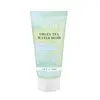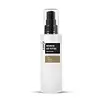What's inside
What's inside
 Key Ingredients
Key Ingredients

 Benefits
Benefits

 Concerns
Concerns

 Ingredients Side-by-side
Ingredients Side-by-side

Water
Skin ConditioningButylene Glycol
HumectantCaprylic/Capric Triglyceride
MaskingCamellia Sinensis Leaf Extract
AntimicrobialSqualane
EmollientNiacinamide
SmoothingGlycerin
HumectantDicaprylyl Carbonate
EmollientSodium Hyaluronate
HumectantPolyglutamic Acid
Skin ConditioningCopper Tripeptide-1
Skin ConditioningSh-Polypeptide-7
AntiseborrhoeicSh-Decapeptide-7
AntioxidantSh-Octapeptide-4
AntioxidantSh-Oligopeptide-9
HumectantSh-Pentapeptide-19
Skin ConditioningGlyceryl Stearate
EmollientAdansonia Digitata Seed Oil
EmollientAllantoin
Skin ConditioningDipotassium Glycyrrhizate
HumectantPanthenol
Skin ConditioningZanthoxylum Piperitum Fruit Extract
Skin ConditioningPulsatilla Koreana Extract
Skin ConditioningUsnea Barbata Extract
Cetearyl Alcohol
Emollient1,2-Hexanediol
Skin ConditioningAdenosine
Skin ConditioningCarbomer
Emulsion StabilisingArginine
MaskingDisodium EDTA
Propanediol
SolventCaprylhydroxamic Acid
Sodium Polyacryloyldimethyl Taurate
Emulsion StabilisingDicaprylyl Ether
EmollientPentylene Glycol
Skin ConditioningPolyglyceryl-10 Dilaurate
Caprylyl Glycol
EmollientTocopherol
AntioxidantWater, Butylene Glycol, Caprylic/Capric Triglyceride, Camellia Sinensis Leaf Extract, Squalane, Niacinamide, Glycerin, Dicaprylyl Carbonate, Sodium Hyaluronate, Polyglutamic Acid, Copper Tripeptide-1, Sh-Polypeptide-7, Sh-Decapeptide-7, Sh-Octapeptide-4, Sh-Oligopeptide-9, Sh-Pentapeptide-19, Glyceryl Stearate, Adansonia Digitata Seed Oil, Allantoin, Dipotassium Glycyrrhizate, Panthenol, Zanthoxylum Piperitum Fruit Extract, Pulsatilla Koreana Extract, Usnea Barbata Extract, Cetearyl Alcohol, 1,2-Hexanediol, Adenosine, Carbomer, Arginine, Disodium EDTA, Propanediol, Caprylhydroxamic Acid, Sodium Polyacryloyldimethyl Taurate, Dicaprylyl Ether, Pentylene Glycol, Polyglyceryl-10 Dilaurate, Caprylyl Glycol, Tocopherol
Water
Skin ConditioningButylene Glycol
HumectantCaprylic/Capric Triglyceride
MaskingHelianthus Annuus Seed Oil
EmollientButylene Glycol Dicaprylate/Dicaprate
EmollientNiacinamide
SmoothingSodium Hyaluronate
Humectant1,2-Hexanediol
Skin ConditioningArachidyl Alcohol
EmollientBehenyl Alcohol
EmollientArachidyl Glucoside
EmulsifyingCyclomethicone
EmollientAdenosine
Skin ConditioningGlycerin
HumectantHydrogenated Lecithin
EmulsifyingSh-Oligopeptide-1
Skin ConditioningCopper Tripeptide-1
Skin ConditioningGlyceryl Stearate
EmollientPEG-100 Stearate
Polysorbate 60
EmulsifyingDiisostearyl Malate
EmollientDimethicone
EmollientMyrciaria Dubia Fruit Extract
Skin ConditioningEuterpe Oleracea Fruit Extract
Sorbitan Stearate
EmulsifyingAllantoin
Skin ConditioningXanthan Gum
EmulsifyingTocopheryl Acetate
AntioxidantLonicera Japonica Flower Extract
Skin ConditioningSolanum Lycopersicum Fruit Extract
AntioxidantLilium Tigrinum Extract
Skin ConditioningNelumbo Nucifera Seed Extract
AntimicrobialChrysanthemum Indicum Flower Extract
Skin ConditioningHydrolyzed Collagen
EmollientAcanthopanax Senticosus Root Extract
Skin ConditioningPunica Granatum Fruit Extract
AntioxidantPanax Ginseng Root Extract
EmollientCarthamus Tinctorius Flower Extract
Skin ConditioningCarbomer
Emulsion StabilisingDisodium EDTA
Arginine
MaskingMalva Sylvestris Flower Extract
Skin ConditioningBuddleja Davidii Extract
Skin ConditioningThymus Vulgaris Extract
PerfumingCamellia Sinensis Callus Culture Extract
PerfumingPhaseolus Radiatus Meristem Cell Culture Extract
Skin ConditioningPanax Ginseng Callus Culture Extract
Skin ConditioningEthylhexylglycerin
Skin ConditioningPyrus Malus Leaf Extract
Skin ConditioningTheobroma Cacao Extract
Skin ConditioningVanilla Planifolia Fruit Extract
Skin ConditioningFragaria Chiloensis Fruit Extract
Skin ConditioningPrunus Persica Fruit Extract
AbrasiveMusa Sapientum Fruit Extract
Skin ConditioningCocos Nucifera Oil
MaskingPrunus Domestica Fruit Extract
MoisturisingWater, Butylene Glycol, Caprylic/Capric Triglyceride, Helianthus Annuus Seed Oil, Butylene Glycol Dicaprylate/Dicaprate, Niacinamide, Sodium Hyaluronate, 1,2-Hexanediol, Arachidyl Alcohol, Behenyl Alcohol, Arachidyl Glucoside, Cyclomethicone, Adenosine, Glycerin, Hydrogenated Lecithin, Sh-Oligopeptide-1, Copper Tripeptide-1, Glyceryl Stearate, PEG-100 Stearate, Polysorbate 60, Diisostearyl Malate, Dimethicone, Myrciaria Dubia Fruit Extract, Euterpe Oleracea Fruit Extract, Sorbitan Stearate, Allantoin, Xanthan Gum, Tocopheryl Acetate, Lonicera Japonica Flower Extract, Solanum Lycopersicum Fruit Extract, Lilium Tigrinum Extract, Nelumbo Nucifera Seed Extract, Chrysanthemum Indicum Flower Extract, Hydrolyzed Collagen, Acanthopanax Senticosus Root Extract, Punica Granatum Fruit Extract, Panax Ginseng Root Extract, Carthamus Tinctorius Flower Extract, Carbomer, Disodium EDTA, Arginine, Malva Sylvestris Flower Extract, Buddleja Davidii Extract, Thymus Vulgaris Extract, Camellia Sinensis Callus Culture Extract, Phaseolus Radiatus Meristem Cell Culture Extract, Panax Ginseng Callus Culture Extract, Ethylhexylglycerin, Pyrus Malus Leaf Extract, Theobroma Cacao Extract, Vanilla Planifolia Fruit Extract, Fragaria Chiloensis Fruit Extract, Prunus Persica Fruit Extract, Musa Sapientum Fruit Extract, Cocos Nucifera Oil, Prunus Domestica Fruit Extract
 Reviews
Reviews

Ingredients Explained
These ingredients are found in both products.
Ingredients higher up in an ingredient list are typically present in a larger amount.
1,2-Hexanediol is a synthetic liquid and another multi-functional powerhouse.
It is a:
- Humectant, drawing moisture into the skin
- Emollient, helping to soften skin
- Solvent, dispersing and stabilizing formulas
- Preservative booster, enhancing the antimicrobial activity of other preservatives
Adenosine is in every living organism. It is one of four components in nucleic acids that helps store our DNA.
Adenosine has many benefits when used. These benefits include hydrating the skin, smoothing skin, and reducing wrinkles. Once applied, adenosine increases collagen production. It also helps with improving firmness and tissue repair.
Studies have found adenosine may also help with wound healing.
In skincare products, Adenosine is usually derived from yeast.
Learn more about AdenosineAllantoin is a soothing ingredient known for its protective and moisturizingg properties. Because of this, it is often added to products with strong active ingredients.
Studies show higher concentrations of this ingredient can promote wound healing.
Though it can be derived from the comfrey plant, allantoin is produced synthetically for cosmetic products to ensure purity.
Learn more about AllantoinArginine is an amino acid that is important for human development. Your body uses is it to produce hair keratin and skin collagen.
As a cosmetic ingredient, Arginine has antioxidant properties and can also help repair damaged skin. This ingredient is derived either synthetically or from animals.
Arginine isn't fungal acne safe when used in the presence of other lipids (fats, fatty acids, oils, esters, etc). Oils and fats occur naturally within the skin, so take caution when using Arginine if you're prone to fungal acne.
Learn more about ArginineButylene Glycol (or BG) is used within cosmetic products for a few different reasons:
Overall, Butylene Glycol is a safe and well-rounded ingredient that works well with other ingredients.
Though this ingredient works well with most skin types, some people with sensitive skin may experience a reaction such as allergic rashes, closed comedones, or itchiness.
Learn more about Butylene GlycolThis ingredient is an emollient, solvent, and texture enhancer. It is considered a skin-softener by helping the skin prevent moisture loss.
It helps thicken a product's formula and makes it easier to spread by dissolving clumping compounds.
Caprylic Triglyceride is made by combining glycerin with coconut oil, forming a clear liquid.
While there is an assumption Caprylic Triglyceride can clog pores due to it being derived from coconut oil, there is no research supporting this.
Learn more about Caprylic/Capric TriglycerideCarbomer is a polymer of acrylic acid. Its main role is to create a gel consistency.
A high amount of carbomer can cause pilling or balling up of products. Don't worry, most products contain 1% or less of carbomer.
Copper Tripeptide-1 (GHK-Cu) is a skin repairing ingredient known for its ability to boost collagen, improve firmness, and support skin regeneration.
It is a complex made up of a naturally occurring peptide (glycine-histidine-lysine) and copper, an essential trace element.
While studying wound healing, researchers noticed GHK-Cu stimulated hair follicle enlargement and growth by keeping hair in its active growth phase longer. This has made it a promising ingredient for hair regrowth treatments.
Some people have reported increased facial hair. While GHK-Cu can make your hair follicles bigger, it usually doesn’t turn soft, barely-visible facial hairs into thick, dark ones.
Anecdotal reports suggest that overusing copper peptides might lead to premature aging due to excess free copper or enzyme imbalances. This claim isn’t backed by large-scale studies.
Unfortunately, there are limited human studies for this ingredient. While early results are promising, many studies are either small, in-vitro, or not rigorously controlled.
For example, there is a 1998 study that explored the effects of copper tripeptide, vitamin C, tretinoin, and melatonin on skin repair and collagen synthesis.
After one month, increased procollagen production was seen in 7 out of 10 participants using copper tripeptide (more than those using vitamin C, melatonin, or tretinoin.
While the study was exploratory, it offers early evidence that copper tripeptide may support collagen production. Larger, well-designed trials are still needed to confirm its potential and understand individual responses.
Read more about other common types of peptides here:
Learn more about Copper Tripeptide-1Disodium EDTA plays a role in making products more stable by aiding other preservatives.
It is a chelating agent, meaning it neutralizes metal ions that may be found in a product.
Disodium EDTA is a salt of edetic acid and is found to be safe in cosmetic ingredients.
Learn more about Disodium EDTAGlycerin is already naturally found in your skin. It helps moisturize and protect your skin.
A study from 2016 found glycerin to be more effective as a humectant than AHAs and hyaluronic acid.
As a humectant, it helps the skin stay hydrated by pulling moisture to your skin. The low molecular weight of glycerin allows it to pull moisture into the deeper layers of your skin.
Hydrated skin improves your skin barrier; Your skin barrier helps protect against irritants and bacteria.
Glycerin has also been found to have antimicrobial and antiviral properties. Due to these properties, glycerin is often used in wound and burn treatments.
In cosmetics, glycerin is usually derived from plants such as soybean or palm. However, it can also be sourced from animals, such as tallow or animal fat.
This ingredient is organic, colorless, odorless, and non-toxic.
Glycerin is the name for this ingredient in American English. British English uses Glycerol/Glycerine.
Learn more about GlycerinGlyceryl Stearate is a mix of glycerin and stearic acid.
It is used to stabilize the mixing of water and oil ingredients. By preventing these ingredients from separating, it can help elongate shelf life. It can also help thicken the product's texture.
As an emollient, it helps soften skin and supports barrier-replenishing ingredients.
In cosmetics, Glyceryl Stearate is often made from vegetable oils or synthetically produced.
This ingredient may not be fungal-acne safe
Fun fact: The human body also creates Glyceryl Stearate naturally.
Learn more about Glyceryl StearateNiacinamide is a multitasking form of vitamin B3 that strengthens the skin barrier, reduces pores and dark spots, regulates oil, and improves signs of aging.
And the best part? It's gentle and well-tolerated by most skin types, including sensitive and reactive skin.
You might have heard of "niacin flush", or the reddening of skin that causes itchiness. Niacinamide has not been found to cause this.
In very rare cases, some individuals may not be able to tolerate niacinamide at all or experience an allergic reaction to it.
If you are experiencing flaking, irritation, and dryness with this ingredient, be sure to double check all your products as this ingredient can be found in all categories of skincare.
When incorporating niacinamide into your routine, look out for concentration amounts. Typically, 5% niacinamide provides benefits such as fading dark spots. However, if you have sensitive skin, it is better to begin with a smaller concentration.
When you apply niacinamide to your skin, your body converts it into nicotinamide adenine dinucleotide (NAD). NAD is an essential coenzyme that is already found in your cells as "fuel" and powers countless biological processes.
In your skin, NAD helps repair cell damage, produce new healthy cells, support collagen production, strengthen the skin barrier, and fight environmental stressors (like UV and pollution).
Our natural NAD levels start to decline with age, leading to slower skin repair, visible aging, and a weaker skin barrier. By providing your skin niacinamide, you're recharging your skin's NAD levels. This leads to stronger, healthier, and younger looking skin.
Another name for vitamin B3 is nicotinamide. This vitamin is water-soluble and our bodies don't store it. We obtain Vitamin B3 from either food or skincare. Meat, fish, wheat, yeast, and leafy greens contain vitamin B3.
The type of niacinamide used in skincare is synthetically created.
Learn more about NiacinamideSodium Hyaluronate is hyaluronic acid's salt form. It is commonly derived from the sodium salt of hyaluronic acid.
Like hyaluronic acid, it is great at holding water and acts as a humectant. This makes it a great skin hydrating ingredient.
Sodium Hyaluronate is naturally occurring in our bodies and is mostly found in eye fluid and joints.
These are some other common types of Hyaluronic Acid:
Learn more about Sodium HyaluronateWater. It's the most common cosmetic ingredient of all. You'll usually see it at the top of ingredient lists, meaning that it makes up the largest part of the product.
So why is it so popular? Water most often acts as a solvent - this means that it helps dissolve other ingredients into the formulation.
You'll also recognize water as that liquid we all need to stay alive. If you see this, drink a glass of water. Stay hydrated!
Learn more about Water